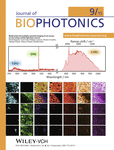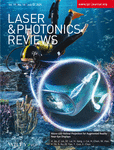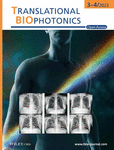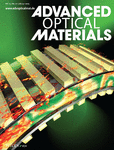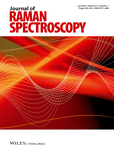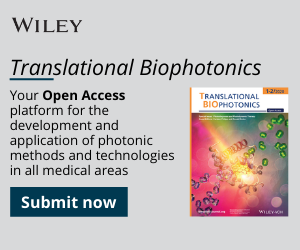Journal list menu
Export Citations
Download PDFs
Cover Picture
Cover Picture: Multimodal and multiplex spectral imaging of rat cornea ex vivo using a white-light laser source (J. Biophotonics 9/2015)
- First Published: 01 September 2015
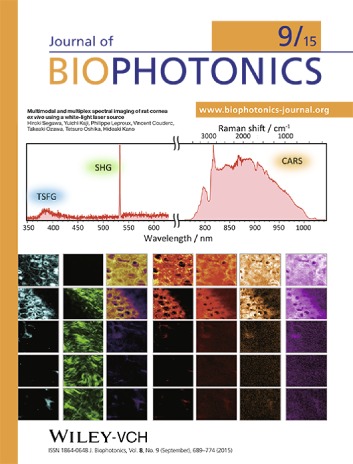
Multimodal nonlinear spectral imaging with coherent anti-Stokes Raman scattering (CARS) molecular fingerprinting was applied to ex vivo measurement of rat cornea. Complicated inner structure of the cornea was clearly visualized with molecular structural information produced by combined spectral analysis of multiplex CARS, second harmonic generation (SHG) and multiplex third-order sum frequency generation (TSFG). This study will open the door for molecular level analysis in corneal medical diagnostics.
(Picture: H. Segawa et al., pp. 705–713 in this issue)
Issue Information
Contents
Full Articles
The use of optical trap and microbeam to investigate the mechanical and transport characteristics of tunneling nanotubes in tumor spheroids
- Pages: 694-704
- First Published: 29 October 2014
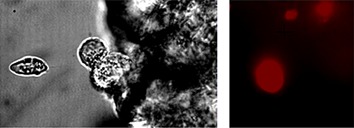
The use of optical trap and microbeam for investigating mechanical and transport properties of inter cellular tunneling nanotubes (TnTs) in tumor spheroids has been demonstrated. TnTs in tumor spheroids have been visualized by manipulating TnT connected cells using optical tweezers. Functionality of the TnTs for transferring cytoplasmic vesicles and injected dye molecules by optoporation method has been studied. Further, the TnTs could be longitudinally stretched by manipulating the connected cells and their elastic response was studied.
Editor's Choice
Multimodal and multiplex spectral imaging of rat cornea ex vivo using a white-light laser source
- Pages: 705-713
- First Published: 06 November 2014
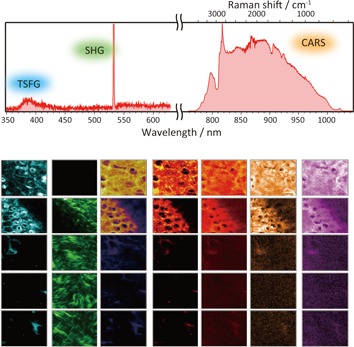
Multimodal nonlinear spectral imaging with coherent anti-Stokes Raman scattering (CARS) molecular fingerprinting was applied to ex vivo measurement of rat cornea. Complicated inner structure of the cornea was clearly visualized with molecular structural information produced by combined spectral analysis of multiplex CARS, second harmonic generation (SHG) and multiplex third-order sum frequency generation (TSFG). This study will open the door for molecular level analysis in corneal medical diagnostics.
Full Articles
In-vitro investigations on laser-induced smoke generation mimicking the laparoscopic laser surgery purposes
- Pages: 714-722
- First Published: 03 November 2014
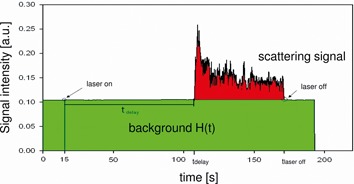
Intraoperative smoke generation is an adherent phenomenon to laser-assisted surgery that could obscure surgical-vision. An experimental setup mimicking clinical laparoscopy is used to detect smoke-production. This time dependent signal correlates to the ablation-rate. Smoke generation depends on the optical properties of tissue and thus on the laser wavelength used for ablation. Laparoscopic surgeons should be aware of specific wave-length-laser-tissue interaction, avoiding carbonization during cutting/coagulation to reduce smoke-generation yielding visual advantages.
Assessment of ALA-induced PpIX production in porcine skin pretreated with microneedles
- Pages: 723-729
- First Published: 15 October 2014
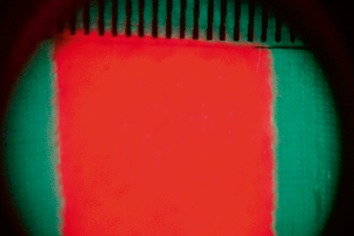
Photodynamic therapy (PDT) for skin treatment of premalignant and cancer lesions combines tissue photosensitization and subsequent exposure to light to induce cell death. As it is limited to the treatment of superficial lesions, mainly due to the low cream penetration, the improvement of transdermal distribution of aminolevulinic acid (ALA) is needed. In this study, the kinetics and homogeneity of production of ALA-induced PpIX after the skin pre-treatment with microneedle rollers were investigated.
Polarization second harmonic generation microscopy provides quantitative enhanced molecular specificity for tissue diagnostics
- Pages: 730-739
- First Published: 03 November 2014
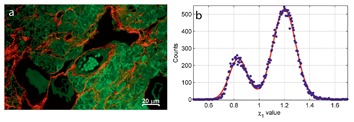
Polarization dependent effects introduced by optics present in a commercial microscope can create artifact in susceptibility (χ) image, which ultimately may lead to misleading results. This report discusses the issues responsible for image artifacts in p-SHG analysis and provides the relevant solutions in terms of calibrations. Moreover, as a proof-of-concept, χ-parameters value of a heart muscle, ovary tissue and osteoarthritic cartilage was obtained by p-SHG analysis.
Light-emitting diode therapy in exercise-trained mice increases muscle performance, cytochrome c oxidase activity, ATP and cell proliferation
- Pages: 740-754
- First Published: 06 November 2014

Light-emitting diode therapy (LEDT) applied over the leg, gluteus and lower-back muscles of mice using a LED cluster increased muscle performance, ATP and mitochondrial metabolism; oxidative stress and proliferative myocyte markers in mice subjected to acute and progressive strength training. Six bi-daily training sessions LEDT-After and LEDT-Before-After regimens more than doubled muscle performance and increased ATP more than tenfold. The effectiveness of LEDT on improving muscle performance and recovery suggest applicability for high performance sports and in training programs.
Detection and controlled depletion of cancer cells using photothermal phase microscopy
- Pages: 755-763
- First Published: 17 November 2014
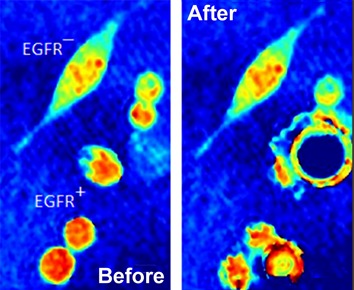
Laser therapy for real-time, selective cancer treatment is now one step closer to realization, as a new method for ablating cancer cells specifically is implemented. The system is comprised of a photothermal phase interferometer, which can quantitatively image all cells in an in vitro sample, labeled and unlabeled, and then selectively choose cells for ablation using novel image contrast mechanism that is based on the heat signatures of gold nanoparticles.
GJIC Enhances the phototoxicity of photofrin-mediated photodynamic treatment by the mechanisms related with ROS and Calcium pathways
- Pages: 764-774
- First Published: 19 January 2015
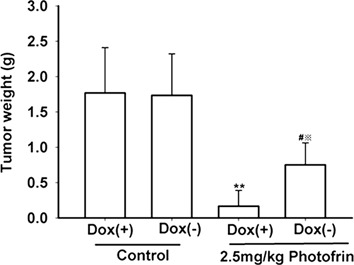
Despite initially positive responses, recurrences after Photodynamic treatment (PDT) can occur and there is need for improvement in the effectiveness of PDT. It is shown that the presence of GJIC (Connexin32) increased the PDT phototoxicity in cell and animal level, which was related with ROS and calcium pathways. The study indicates the possibility that up-regulation or maintenance of GJ functionality may be used to increase the efficacy of PDT.




